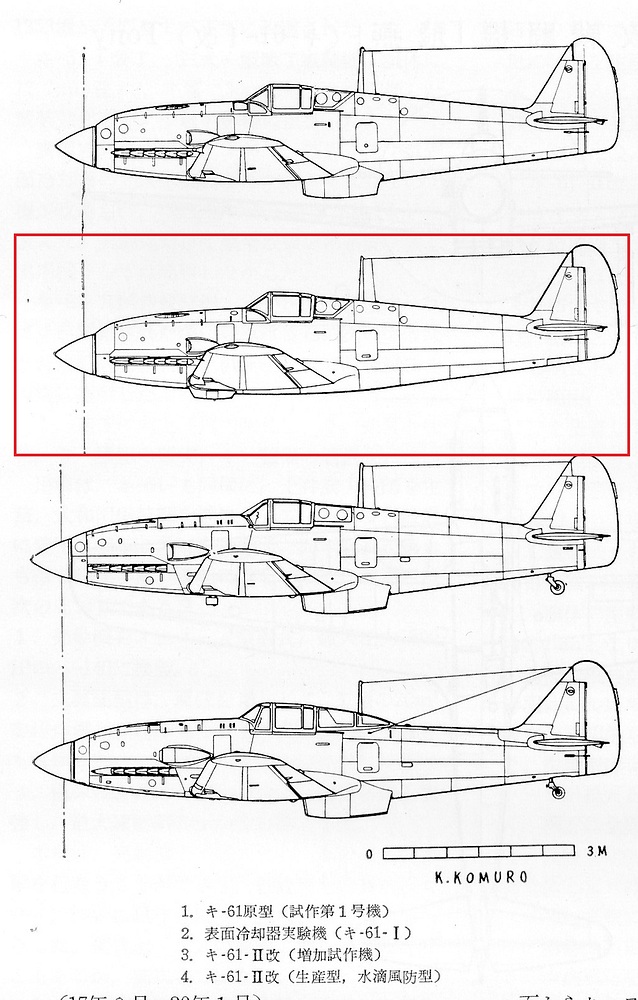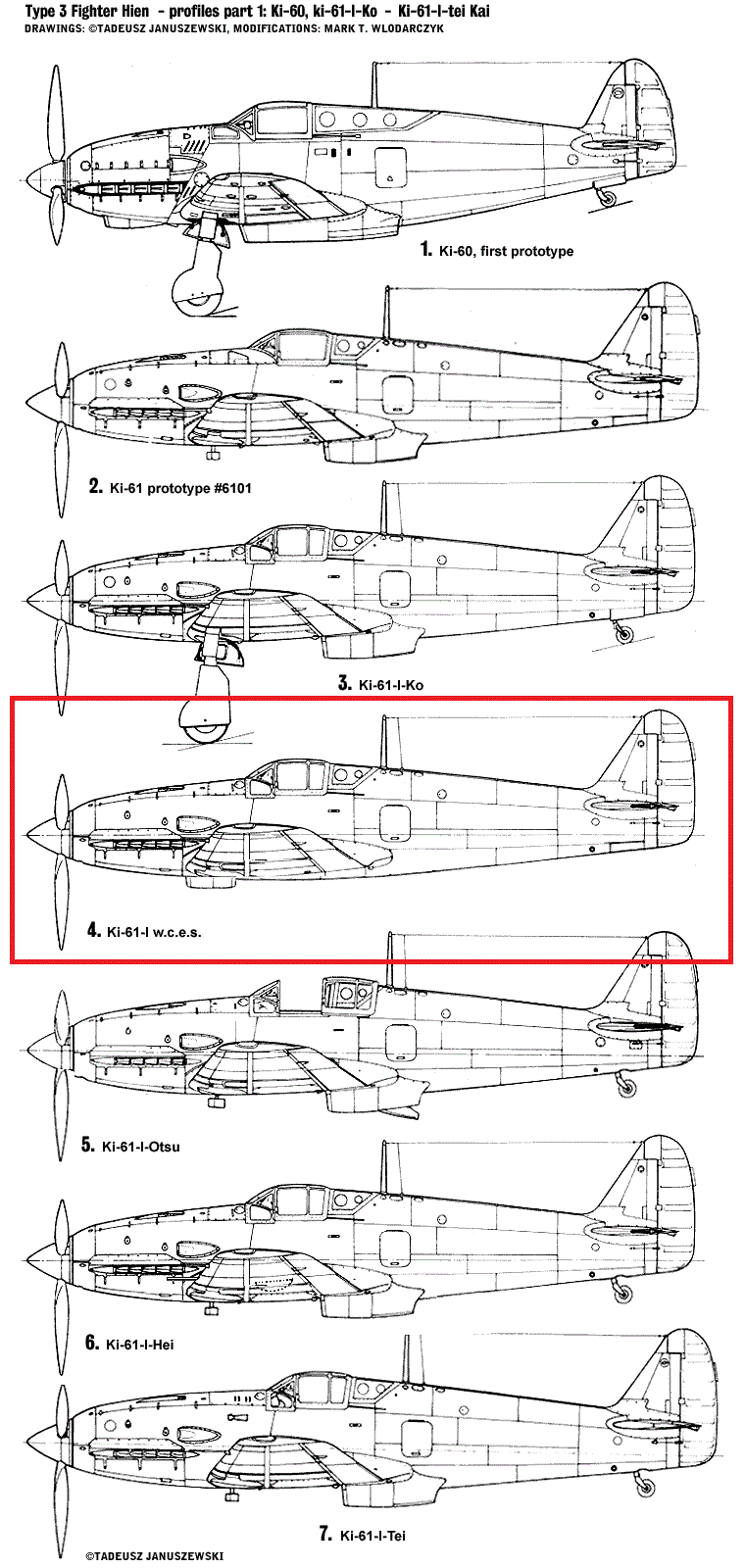- Yes
- No
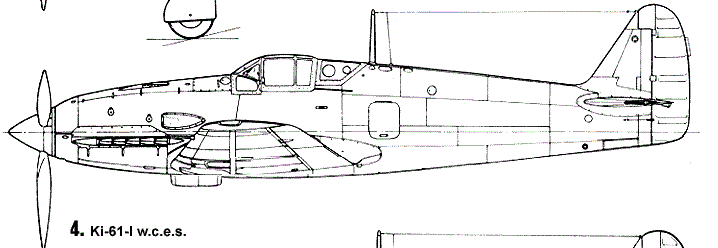
Experimental Kawasaki Ki-61-I with suface evaporation cooling system (表面冷却器実験機 キ61)
The experimental Kawasaki Ki-61-I with a surface evaporation cooling system is a Japanese experimental fighter that was developed in the autumn of 1942 from the conversion of the Ki-61-I Ko (probably the second prototype of the Ki-61). This aircraft served as a research aircraft for the surface cooling system installed in the wings, which was later used in the Kawasaki Ki-64.
History
In November 1940, when Takeo Doi received permission from the Japanese Army to build his unconventional interceptor aircraft, the Kawasaki Ki-64, the search for a suitable engine for this aircraft began. It was decided to use two Kawasaki Ha-40 engines connected by a drive shaft, which were designated as Kawasaki Ha-201. The Ha-201 engine was to provide the enormous power (2,350 HP) needed for the new aircraft; however, it required efficient cooling to avoid destruction. Classic cooling through radiators under the fuselage seemed like a good solution, but due to the design of the future Ki-64, it was not a viable option. Because of the arrangement of the two engines behind each other, two cooling systems using radiators would be needed, which would cause very high aerodynamic drag and reduce the aircraft’s performance. The solution to the cooling problem for the future Kawasaki Ki-64 came from an unexpected source, namely from the Japanese Navy. In May 1940, three Henkiel He-100 fighters reached Japan, along with technical documentation for their licensed production. Most importantly, the Henkiel He-100 had an extraordinary cooling system in its wings, which became the key to solving the cooling problem for the Kawasaki Ki-64. The Japanese navy provided Kawasaki with the technical documentation for the He-100, allowing the work on the Ki-64 to continue. However, no one wanted to install an untested technical solution in a prototype aircraft, so it was decided to use one of the new Kawasaki Ki-61 planes. The work on the Kawasaki Ki-61 took place nearly parallel to that of the Ki-64 (which is why they are quite similar), and it flew for the first time in December 1941. When the testing of the Ki-61 was completed and production of these fighters began in August 1942, Takeo Doi decided to use one of the Ki-61s (probably the second prototype) for cooling tests for the Ki-64. The Ki-61-I Ko, which was to receive a surface evaporation cooling system in its wings, was developed in the autumn of 1942 and was ready in October of that same year. The aircraft had the radiator and cooler removed from under the fuselage, and a cooling system with a surface area of 14 m2 was installed in the wings. The cooling system took up space, so it is likely that the fuel tanks in the wings were completely removed or significantly reduced. The modified Ki-61 was used for tests from October 1942 to December 1943, during which it completed 35 test flights and various ground tests. The experimental Kawasaki Ki-61-I with the surface evaporation cooling system was tested for performance increase in flight, the durability of such a cooling system, and many other parameters that later proved useful in the Kawasaki Ki-64. The experimental Ki-61 showed an improvement in flight performance by 30-48 km/h in maximum speed, so for a while, the possibility of using the new cooling system in production aircraft was considered. However, the ordinary Kawasaki Ki-61 already suffered from significant reliability problems (especially with the engines), so the introduction of the complex and difficult-to-maintain surface evaporation cooling system was considered a bad idea and was abandoned. It is unknown what happened to the Experimental Kawasaki Ki-61-I with the surface evaporation cooling system after its tests concluded in December 1943. (Link if you are interested in the fate of the Kawasaki Ki-64).
Photo of Experimental Kawasaki Ki-61-I with suface evaporation cooling system
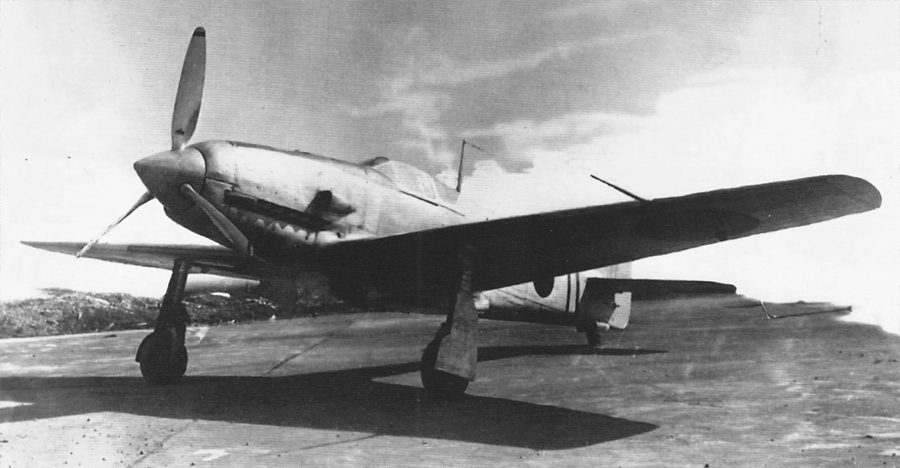
Art about the Experimental Kawasaki Ki-61-I with surface evaporation cooling system
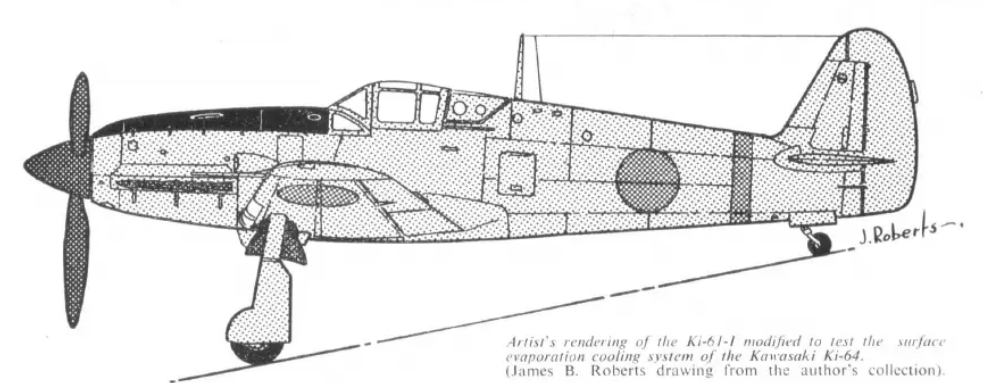
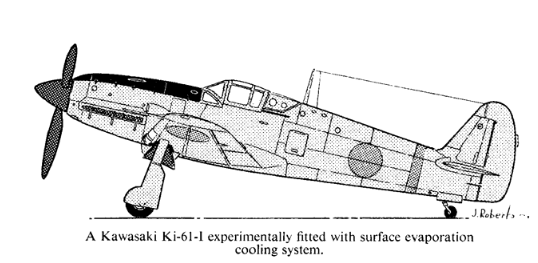
Construction description
The experimental Kawasaki Ki-61-I with a surface evaporation cooling system is based on the Kawasaki Ki-61-I Ko fighter, but it has very important modifications that I will describe here.
- The cooler under the hull has been removed.
- A cooling system was installed in the wings with an area of 14m2.
- The fuel tanks in the wings have been reduced or completely removed.
Technical sketches
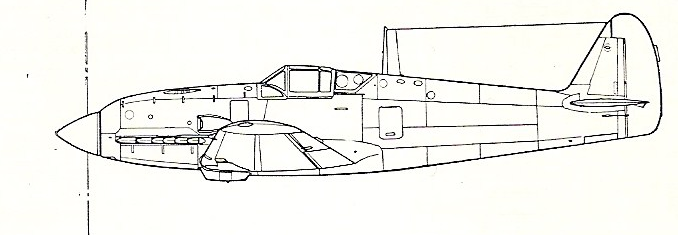
Comparison of the Experimental Kawasaki Ki-61-I with surface evaporation cooling system with other variants of Ki-61
General characteristics
- Crew: 1
- Length: 8,74 m
- Wingspan: 12,00 m
- Height: 3,70 m
- Wing area: 20 m2
- Empty weight: 2,170 kg (?)
- Gross weight: 3,130 kg (?)
- Powerplant: 1 × Kawasaki Ha-40 (Ha-60-22) water-cooled inverted twelve-cylinder V-engine with a start power of 864 kW (1175 hp)
- Propellers: 3-bladed constant-speed propeller, 3,000 mm diameter
Performance
- Maximum speed: 625-638 km/h
- Cruising speed: 450 km/h (?)
- Range: 600 km (?)
- Maximum Range: ?
- Service Ceiling: 11600 m
- Time to Climb: 5,31 min do 5000 m (?)
Armament
- Fixed armament
- 2 x 12,7 mm Ho-103 machine guns above the engine (200 rounds each)
- 2 x 7,7 mm Type 89 Model 2 machine gun in the wings (500 rounds each)
- Bombs
- 2 x 30 kg bomb(?)
- 2 x 50 kg bomb (?)
- 2 x 100 kg bomb (?)
- 2 x 250 kg bomb (?)
- Fuel dump tanks
- 2 x 200 l dump tanks
Armour
- Self-sealing fuel tanks
- 16 mm armor plate on the headrest of the seat
- 12 mm armor plate behind the pilot’s seat
Special thanks
Summary
The experimental Kawasaki Ki-61-I with a surface evaporation cooling system is an interesting aircraft for Japan in War Thunder. This aircraft would be the fastest version of the Kawasaki Ki-61 fighter, offering new combat capabilities. Of course, due to the implementation of cooling in the wings, this aircraft will have huge problems with engine cooling in case of wing damage. The experimental Ki-61, because of its uniqueness, is perfectly suited to be a fighter for an event or premium, although it would certainly be a very nice addition as an aircraft to research. I encourage you to discuss in the comments and to share your own knowledge on this subject.
Finally, I apologize for the linguistic and logical errors because unfortunately English is not my main language and I had to use google translator.
Internet sources
A0000191.html
Kawasaki Ki-61 - Wikipedia
Kawasaki Ki-64 (“Rob”) Experimental Heavy Fighter | Secret Projects Forum
Уголок неба ¦ Kawasaki Ki-61 Hien
:: Artigos da Webkits Modelismo ::
【戦闘機】『三式戦闘機 飛燕』異色の液冷エンジン装備戦闘機 : トイレで読む向けブログ
(1) 大野正裕 w serwisie X: „630km/hというのはおそらく、無武装の飛燕試作機が発揮した590km/hに、土井さんが書いた蒸気冷却による増速効果40km/hを読者が加算した数値だろう。 この40km/hというのは多分計画値であって、蒸気冷却の担当佐々技師が1944/3/20に大日本航空技術協会で発表した実績値は35km/h。ただ、計器指示等の https://t.co/mukAIvflMD” / X
Japanese Aircraft of WWII: Kawasaki Ki-64
Book sources
- Technika wojskowa historia 4/2020 (Military Technology: History 4/2020) page 7-8
- Japanese Aircraft of the Pacific War page 115
- Japanese Secret Projects Experimental Aircraft of the IJA & IJN 1939-1945, page 10
- (Monografie Lotnicze No.5) Kawasaki Ki-61 Hien page 10
(Monografie Lotnicze No.5) Kawasaki Ki-61 Hien | PDF - 118 - Profile Publications - Aircraft Profile - The Kawasaki Ki-61 Hien page 7
118 - Profile Publications - Aircraft Profile - The Kawasaki Ki-61 Hien | PDF - Fighters of the Dying Sun page 41
- Japanese Heavy Fighters 1937-1945 , page 75
- 日本航空機辞典 1910年(明治43年)~1945年(昭和20年) 上巻 (Encyclopedia of Japanese Aircraft 1910 (Meiji 43) – 1945 (Showa 20), Volume 1) page 108-110
- 野沢正『日本航空機総集 川崎篇』出版協同社, page 142-154
- 世界の傑作機 文林堂1984年5月号★143. 三式戦闘機 飛燕

Thank you for reading the suggestion, see you in the next one. Good luck pilots

